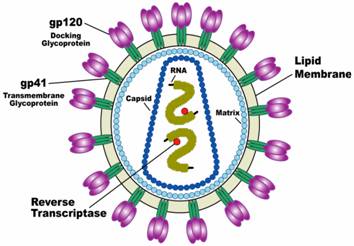HIV Virus
Human immunodeficiency virus (HIV) is a lentivirus (a member of the retrovirus family). It is composed of two copies of positive single-stranded RNA enveloped by nucleocapsid protein. This is, in turn, surrounded by the viral envelope that is composed of phospholipids taken from the membrane of a human cell when a newly formed virus particle buds from the cell. A glycoprotein complex consists of a cap made of three molecules called glycoprotein (gp) 120, and a stem consisting of three gp41 molecules that anchor the structure into the viral envelope. This glycoprotein complex enables the virus to attach to and fuse with target cells to initiate the infectious cycle. (Figure 1)
Figure 1:HIV virion (Reproduced from http://en.wikipedia.org/wiki/HIV)
 |
HIV Virus classification
There are 2 main types of HIV virus – Type 1 and Type 2. HIV-1 virus is classified into the M (Main), O (Outlyer) and N (neither M nor O groups) with the M group further divided into subtypes (clades) A-K. There are geographic distributions of various sub types of HIV-1 across the globe. Within North America and Europe, the virus is of subtype B. By contrast in sub-Saharan Africa predominant viruses are subtypes C, A, D, F and G. In India, the commonest HIV-1 subtype circulating is subtype C. HIV-1 is more virulent, more infective. By contrast, HIV-2 has more limited variation and is less pathogenic than HIV-1 in humans and infection is limited to West Africa.